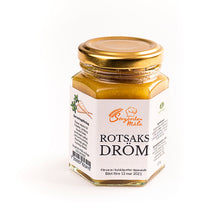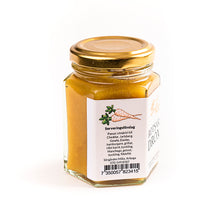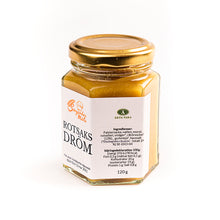
Root dream, the best root fruit delicacy on the market! Our wonderful mixture of parsnip, carrot and celeriac is a real sensation for the taste buds. With its combination of root vegetables and spices, Rotsaksdröm is the perfect companion for every occasion. It brings out the natural flavors of vegetables and adds an extra dimension to your favorite dishes.
What makes Rotsaksdröm so special is its usability. It can be used as a marinade for grilled vegetables or as a seasoning in soups, stews and other dishes. Its rich flavor and versatility make it an invaluable tool in the kitchen.
In addition, Rotsaksdröm is made from fresh and nutritious ingredients that give you a healthy meal with every bite. It is also completely natural and free of artificial additives, making it a perfect choice for those who want to eat healthy.
But the best thing about Rotsaksdröm is that it not only adds flavor to your meals, but also makes them more interesting and exciting. With its unique blend of roots and spices, you can easily create new and innovative dishes that will impress your guests.
Root dream also offers many health benefits. It is rich in vitamins, minerals and antioxidants that help strengthen the immune system and improve general health. In addition, regular consumption of root vegetables can reduce the risk of cardiovascular disease and cancer.
Perfect for Cheddar, Jarlsberg, Gouda, Danbo, hamburgers, grilled, smoked loin, chicken, Manchego, goat cheese, chicken, pork fillet
Parsnip . The root has the shape of a carrot, but is larger and white in color. The taste is mild but characteristic. It is a common vegetable in broths and vegetable soups, suitable for au gratin and can be cooked to mash mixed with grated cheese and a little milk. It blooms during the latter part of summer. Parsnip was already cultivated in ancient Greece. In Sweden, it is mentioned in the 16th century, but seems to have been cultivated much earlier, and was in the Middle Ages and the Renaissance considerably more popular as a vegetable than today. Parsnip is an easy-to-grow and hardy kitchen plant.
The carrot, is a popular root vegetable and old cultivated plant, usually orange-coloured, but also occurs in white, yellow, red, purple and black varieties. In terms of shape, they can be conical, cylindrical or spherical. All of these are cultivated forms of the wild carrot (Daucus carota) which occurs naturally in Europe and south-west Asia. The domesticated carrot probably originated in Persia and was originally cultivated for its leaves and seeds. Commonly today the taproot is eaten, although both the stem and the leaves are also edible. Today's carrots have been selectively bred to make the taproot bigger, tastier and less woody. The carrot is a biennial herb in the family of panicle plants and can grow to almost a meter in height. It blooms with white flowers in the second year and the entire plant dies after seeding. Carrots are used in a variety of ways in many countries, both raw and cooked.
Celery is a biennial, strongly scented herb that grows wild in Europe and Asia. Celery grows up to eight centimeters high and blooms in July-August with small white flowers in clusters. The root, stalk and seeds of celery are used. Celery originally comes from Asia but has been cultivated in the Mediterranean area for more than 3,000 years where it began to be used as a spice and medicinal plant already in ancient Egypt. The Romans brought the herb north and it has been known in Sweden since the Middle Ages. It was primarily the seeds and leaves that were used and the development to use celery as a vegetable has been slow. According to information, celeriac was developed in Italy in the 15th century. Celery was developed during the same time, but came to the Nordics later
Ingredients: Parsnip, water, carrot, celery root, vinegar, raw cane sugar (13%), turmeric, sea salt
Amount of fruit 52 g per 100g
Nutrition declaration 100g: Energy 376 kJ/90 kcal; Fat 0.3 g (saturated fat 0.1 g); Carbohydrates 20 g (sugars 19 g); Protein 1 g; Salt 0.8 g









